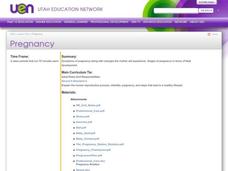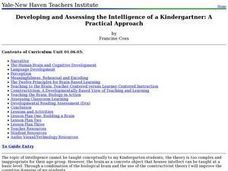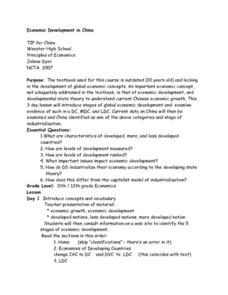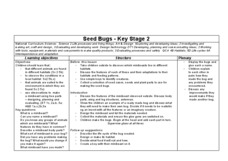Curated OER
Typical Animal Characteristics
How is an animal formed? Scientists use a diagram to examine early post-fertilization stages, and the creation of the blastula. They look at a second diagram to observe the transition from the blastula to a gastrula. Three comprehension...
Curated OER
What's Up With the Water Cycle?
Students explore the water cycle. Students identify the stages in a water cycle and create a PowerPoint presentation based on their knowledge.
Curated OER
The Mass Media and Politics
What effect do the prevalence of televisions in homes have on the American political stage? Challenge your students to consider this idea with these ten questions, both true/false and multiple choice. You could use this activity as a...
Curated OER
Exploring the Hudson in 1609
Learners follow the journey of Henry Hudson down the river with his name. Using journal entries and maps, they learn about its exploration. They use maps to identify stages of the journey, and practice converting distances into miles.
Creative Visions Foundation
Production: Filming
After viewing and analyzing documentaries and working in groups to storyboard and prepare, your class should now be ready for the production stage of the documentary process. The eighth lesson in the series, this plan provides...
Smarter Balanced
Aztec Empire
To set the stage for a study of the Aztec Empire, groups use the provided definition of civilization and generate a list of elements that make up our modern day civilization. The whole class then examines an image of an Aztec city and...
Novelinks
Nightjohn: Anticipation Guide
Set the stage for Nightjohn, Gary Paulsen's young adult novel about slavery set shortly before the Civil War, by asking readers to indicate whether they agree or disagree with several statements that are connected to issues raised by the...
Curated OER
Hermit Crabs Lifecycle & Stages
Students review the life cycle of land hermit crabs by viewing a poster or transparency. They identify the different body parts of a hermit crab and what each part is used for.
Curated OER
Pregnancy
Students view a PowerPoint presentation about pregnancy. They work in groups to complete activities at each of six stations. Students create a baby from clay dough. They use construction paper to design a quilt square. Students complete...
Curated OER
Developing and Assessing the Intelligence of a Kindergartner: A Practical Approach
Students name objects that are the same size, shape, and weight as the human brain. They touch the model brain, feeling the folds, etc. They make connections to the chart displaying the brain-like objects. They touch the 'potato flake'...
Curated OER
Cultural Exchange
Students are introduced to the concept of cultural exchange and identify two examples of the concept. Individually, they research two specific examples of exchange and write about how it affected the two groups involved. They identify...
Curated OER
Discipline vs. Self-Discipline
Students explore self-discipline. For this character education lesson, students define and give examples of discipline and self-discipline. Students work with a group to complete a related concept map.
Curated OER
Animal Life Cycles
Students participate in numerous activities to gather information about parts of the life cycle. In this life science instructional activity, the teacher choose from a number of activities to create or support an interdisciplinary unit...
Curated OER
Wheat: From Field to Oven
How does wheat go from the seed to the table? While focusing on main ideas and supporting statements, class members read an excerpt about wheat production and complete a worksheet. The end goal is a display that shows the different...
Curated OER
Economic Development in China
Students create a poster which depicts and summarizes Rostow's 5 stages of economic development. They make a list of 8 data measures that help identify which level of economic development a country is at. They gather data and...
Curated OER
Life Cycle of a Salamander
Third graders examine the life cycle of a salamander. In this life cycles lesson, 3rd graders view a PowerPoint presentation about the life cycle of a salamander. Students take the temperature of a toy salamander with a thermometer and...
Curated OER
The Artemia Hatchery
Students, in groups, develop their hatcheries, working cooperatively in its design and construction. The lessons begin with the introduction to Artemia as a primary food source of many aquaculture species during their larval stages.
Curated OER
Seed to Plant
Students understand the stages of a plants life. In this stages of plant development lesson, students read about bean plants and grow their own. Students record growth and photograph changes in their plants. Students label the parts of a...
Curated OER
I Can Grow and Change
Students explore activities done at various stages of life. In this personal growth lesson plan, students are read All By Myself by Mercer Mayer and participate in a discussion about how they are growing daily, discuss what activities...
Curated OER
Water, Water Everywhere (Pond Animals)
Second graders examine the characteristics of animals who live in a pond environment. In groups, they describe the various stages in the life of a frog and identify the characteristics of other pond animals. Using this information,...
Curated OER
Zebra, Zebra Where Are Your Stripes?
Young scholars observe the embryological development in the zebrafish. Developmental hierarchy from three germ layers is studied in depth. Research is validated on the body plan of the embryo.
Curated OER
Geology of Waipi'o Valley
Learners predict how the Big Island and Waipi'o Valley formed and write an essay that includes their predictions. They research online to find the real way it formed and experiment with sand to show how a stream develops.
Curated OER
Growing Stages of a Rice Plant
Third graders make a chart to compare the growth of a wheat plant verses the growth of a rice plant. In this planting lesson plan, 3rd graders study the growth of the 2 plants and show the similarities and differences.
Curated OER
Seed Bugs; Stage 2
Students examine nature by participating in an environmental art activity. In this imaginary creature activity, students discuss the importance of a habitat when pertaining to wild animals or bugs. Students utilize tree parts which they...
Other popular searches
- Developmental Stages
- Piaget Developmental Stages
- Developmental Stages of Art
- Child Developmental Stages
- Child Development Stages
- 8 Stages of Development
- Reading Development Stages

























